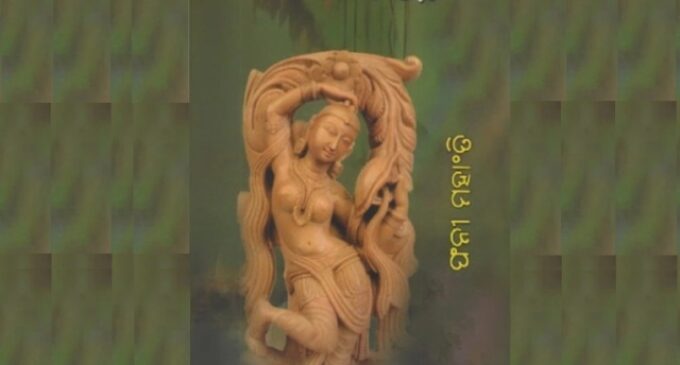Rutambara—Dr. Phani Mohanty’s Poetic Symphony

Reviewed by Dr. Sonali Sahu
Dr. Phani Mohanty, a renowned romantic poet, is celebrated for his profound contribution to Odia literature. Honored with the prestigious Kendra Sahitya Akademi Award, he has been crafting poetry for over five decades, delving into themes of love, emotion, and the subtleties of human relationships. His anthology Rutambara exemplifies his mastery over words and emotions, presenting a vivid landscape of feelings and reflections. The book weaves together delicate nuances of nature and romance, creating a poetic tapestry that resonates deeply with readers. Each poem in Rutambara reveals the intricate interplay of longing and fulfillment, making it a timeless piece that stands as a testament to Dr. Mohanty’s literary prowess and artistic sensitivity.
How painful it is to be far away in a distant land,
Lost in shattered dreams, adrift in the sands.
Like a bird amidst rain-soaked clouds in the sky,
Floating aimlessly, wings spread wide, without a path to fly. ( Page- 9, Rutambara)
The lines capture the profound emotional struggle of displacement, evoking a vivid sense of longing and disorientation. The poet begins by highlighting the pain of being away in a distant land, a sentiment common among those who find themselves far from the comfort of home. This sorrow intensifies in the second line, where the dream-like state transitions into one of shattered illusions, portraying a sense of vulnerability and helplessness.
The imagery of a bird, lost amidst rain-drenched clouds, is particularly striking. The bird symbolizes the human soul—free yet confined, longing to soar yet lacking direction. The “directionless” flight against a murky sky evokes a deep sense of aimlessness and disconnection. Through this metaphor, the poet masterfully intertwines nature and human emotion, illustrating the complexities of the heart when it drifts between hope and despair. The interplay of these elements creates a poignant reflection on the theme of exile, making the reader feel the heaviness of each verse and the gravity of the emotions portrayed.
Somewhere far away, millions of miles apart,
In the deep, dense, luminous, unbroken darkness,
Like an eternal star in the boundless night—
On which unknown planet are you dwelling?
No matter how much I try to reach out, even slightly touch,
My hand seems lost—unable to find its way to you. ( Page-12)
These lines evoke a profound sense of yearning and cosmic isolation, using vivid imagery to highlight the emotional distance between the speaker and their beloved. The phrase “somewhere millions of miles apart” immediately establishes an immense physical and emotional separation, emphasizing the inaccessibility of the beloved. The comparison to a “eternal star” within the deep, dense, luminous, and unbroken darkness beautifully juxtaposes light and dark, hope and despair, reflecting the paradox of being able to see yet not touch, to long yet never reach.
The reference to the beloved dwelling on an “unknown planet” adds a layer of mystery and otherworldliness, suggesting that the beloved is not just far away but in a completely different realm. This imagery extends the metaphor of emotional alienation, as if the beloved exists in a place that defies the speaker’s comprehension and access.
The final lines, where the speaker’s efforts to “slightly touch” are in vain, evoke a sense of helplessness and frustration. The image of the hand being lost or unable to find its way symbolizes the futility of attempting to bridge a gap that cannot be crossed, no matter the effort. This evokes a poignant sense of longing, as if the speaker is suspended in an endless state of desire that remains unfulfilled.
The lines resonate deeply with themes found in the works of renowned poet Pablo Neruda , particularly in his exploration of love, longing, and separation. Neruda’s poetry often encapsulates the essence of longing and the emotional complexities of love. In poems like “If You Forget Me,” he expresses the pain of distance and separation. His imagery frequently merges the physical and emotional realms, illustrating how love transcends distance, much like the speaker’s yearning in your lines. For instance, Neruda writes about how love remains potent despite physical absence, paralleling the sense of unreachable desire in your poem.
She is the woman who has succumbed to love,
In her goddess form, she appears before me,
Glittering like stars, timeless and bright,
A shimmering flame in the floating clouds,
Adorned in the vastness of the azure sky.
Yet she, the beloved, has turned away,
Stubbornly cloaked in her silence (page-20)
These lines beautifully encapsulate the complexities of love, portraying the beloved as a divine figure whose beauty captivates the speaker. The imagery of her as a “goddess” and a “glittering star” evokes ethereal wonder, suggesting that she embodies something otherworldly and timeless. However, this admiration is juxtaposed with a sense of disappointment as the beloved turns away, reflected in the phrase “stubbornly cloaked in her silence.” The dreamy imagery of “floating clouds” and the “azure sky” adds to the poem’s emotional depth, highlighting both the fleeting nature of love and the heartache that often accompanies it. Overall, these lines create a poignant reflection on the dualities of beauty and longing in the human experience.
These lines of Dr Mohanty closely align with the themes found in John Keats’s poetry, particularly in their exploration of beauty, longing, and the idealization of the beloved. The portrayal of the beloved as a “goddess” mirrors Keats’s treatment of his muses, especially in “La Belle Dame sans Merci,” where the knight is captivated by a fairy-like woman, reflecting the overwhelming impact of her beauty. Additionally, the celestial imagery of the beloved as a “glittering star” and the setting of “floating clouds” resonate with Keats’s use of natural elements to express love and admiration, as seen in “Bright Star.” Both poets convey a deep sense of yearning, with your lines reflecting emotional distance through the beloved’s “stubborn” silence, akin to Keats’s themes of longing in “Ode to a Nightingale.” Moreover, the motif of fleeting beauty is present in both works; just as Keats contemplates the eternal beauty captured in art in “Ode on a Grecian Urn,” your depiction of the beloved amidst the clouds suggests an awareness of love’s impermanence. Together, these parallels illustrate the complexities of human emotion, emphasizing how admiration for the beloved can coexist with heartache and a recognition of beauty’s transience.
Bird in a Caged Perch
In the smoky, hazy twilight,
In the honeyed embrace of spring’s delight,
On the day of birth, watched over,
Awaiting the fruits of deeds from a past life’s cover. ( Page- 158)
The lines “Bird in a Caged Perch” reflect a profound sense of confinement and longing, using evocative imagery to convey the complexities of existence. The description of the bird in a “smoky, hazy twilight” suggests uncertainty and melancholy, while the “honeyed embrace of spring’s delight” represents fleeting moments of joy. The reference to the “day of birth” conveys hope and renewal, yet the anticipation of “the fruits of deeds from a past life’s cover” highlights the weight of past actions and their consequences. These themes resonate with the works of renowned poets like Pablo Neruda, who explores existential themes of confinement and longing, and Sylvia Plath, whose reflections on entrapment mirror the desire for liberation found in your lines. Additionally, John Keats’s exploration of beauty and transience in “Ode to a Nightingale” complements the bittersweet emotions present here. These lines beautifully echo the sentiments in the final poem of Rutambara, where the interplay of beauty and longing culminates in a powerful reflection on life’s journey, showcasing the complexities of human emotion.
In conclusion, Rutambara by Dr. Phani Mohanty is a remarkable poetic collection that intricately weaves themes of love, longing, and the complexities of human experience. Through vivid imagery and profound emotional depth, Mohanty captures the essence of existence, inviting readers to reflect on their own journeys. His exploration of divine beauty, the interplay of joy and sorrow, and the weight of past actions resonates deeply, drawing parallels with the works of renowned poets like Pablo Neruda, Sylvia Plath, and John Keats. Each poem in Rutambara serves as a testament to the power of language to articulate the nuances of the human condition, making the collection a significant contribution to contemporary Odia poetry. Dr. Mohanty’s ability to evoke emotion and provoke thought through his verses solidifies Rutambara as a compelling and enriching literary work that will resonate with readers long after the last page is turned.






